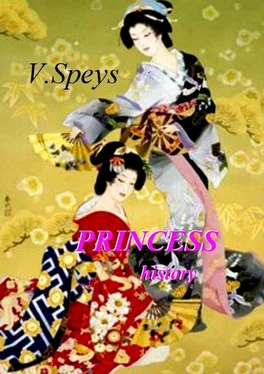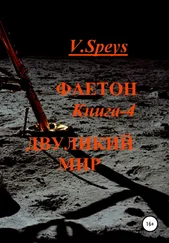V. Speys - Princess history
Здесь есть возможность читать онлайн «V. Speys - Princess history» — ознакомительный отрывок электронной книги совершенно бесплатно, а после прочтения отрывка купить полную версию. В некоторых случаях можно слушать аудио, скачать через торрент в формате fb2 и присутствует краткое содержание. ISBN: , Жанр: Историческая проза, Прочие приключения, на английском языке. Описание произведения, (предисловие) а так же отзывы посетителей доступны на портале библиотеки ЛибКат.
- Название:Princess history
- Автор:
- Жанр:
- Год:неизвестен
- ISBN:9785005341518
- Рейтинг книги:4 / 5. Голосов: 1
-
Избранное:Добавить в избранное
- Отзывы:
-
Ваша оценка:
- 80
- 1
- 2
- 3
- 4
- 5
Princess history: краткое содержание, описание и аннотация
Предлагаем к чтению аннотацию, описание, краткое содержание или предисловие (зависит от того, что написал сам автор книги «Princess history»). Если вы не нашли необходимую информацию о книге — напишите в комментариях, мы постараемся отыскать её.
Princess history — читать онлайн ознакомительный отрывок
Ниже представлен текст книги, разбитый по страницам. Система сохранения места последней прочитанной страницы, позволяет с удобством читать онлайн бесплатно книгу «Princess history», без необходимости каждый раз заново искать на чём Вы остановились. Поставьте закладку, и сможете в любой момент перейти на страницу, на которой закончили чтение.
Интервал:
Закладка:
Princess history
V. Speys
© V. Speys, 2021
ISBN 978-5-0053-4151-8
Created with Ridero smart publishing system
Chapter First
If you look at the map of North Africa, you will see that between the Red Sea and the Nile Valley is the Arabian desert, and along the left bank of the Nile are the sands of the desert of the Libyan Sahara. Egypt is a fertile valley between two deserts: The Sahara or the Libyan and Arabian. The length of this fertile valley is one hundred thirty to one hundred and forty miles. The width is about one mile. On the western side there are gentle slopes of the bare Libyan hills. On the east side are the crooked spurs of the Arabian Upland. Between these lofty deserted banks, the Nile River flows around the snake. From a bird’s-eye view, these shores are clearly visible as they move northward, and thirty miles from the Mediterranean, the river, spreading over several branches, emerges into the plain, forming a triangle, as it were. From this height, the Nile resembles the triangular head of a snake, drinking the waters of the Mediterranean Sea, vigilantly looking for prey with two sparkling eyes: the left – Alexandria and the right – Damietta.
From the end of June to the end of September, the Nile slowly and widely spreads, and from the end of October to May the spring waters gradually come down, exposing the silt-rich land that is rich in silt. Ecologically pure fertile silt replaces chemical fertilizers. A hot climate allows local farmers to grow a rich crop three times a year, completely without worrying to impoverish parts of the flooded land, and thus lose the fertile fertilizer and, consequently, the harvest. Of course Neil is a barn, and harvest, and life. And, to save water all year round, the Egyptians were forced to create a network of canals thousands of miles long. And to protect from floods, to build powerful dams and build reservoirs, which, when drought, were the source of water for watering their lands. Cultivate crops in the hilly terrain of the Egyptians forced to create simple and profitable hydraulic devices, which made it possible to scoop water saturated with fertile silt and pour it into plots. Clean channels, build and repair dams and build roads. All these works were properly carried out in huge territories simultaneously and required a disciplined organization. Egypt managed to create an organized working army at the source, which, the priests were standing, according to the decrees of the pharaohs were fulfilled the plans outlined by the priests. The Egyptian people during this period of their power represented a single organism, governed by the plans of the priests. The diligence of the people, and wise management was that cement of power in the heyday of Egypt, a civilization that reached its heyday five thousand years before our era. Three whales, which relied on the flourishing civilization of Egypt – work, management, planning. Planning – plans were made by wise men, to whom the priests, who had knowledge in astronomy, calendar, healing, future predictions, and so on, were involved. Management – was in the hands of the pharaohs, viceroys of the gods on earth, or the gods themselves, to whom Pharaoh often thought of himself. Pharaoh was also the commander-in-chief of the army, the richest landowner and resource manager. Work – belonged to the people. The country prospered, because it lived as one healthy and healthy organism with a clear distribution of responsibilities. In these distant times, the Egyptian society was divided into two classes of landowners and artisans. Egypt flourished only when the people, the pharaoh and the priests, labored together for the common good…
The boundary separating the fertile land from the desert sands ran along a navigable canal that stretched from Memphis to Lake Timsa and a large caravan route. From the desert, where the caravan route left, from the desert barchans, the canal was still visible all over. From the right side of the hilly bank of the canal, where small groves of acacias, tall sycamore and tamarinds were seen. Among the greenery were seen inconspicuous villas with columns and mud huts, yellow walls and flat roofs. The wavy terrain, which the hills gave, stretched away, hardly resembling a flat hill, but more on a spread rug on which in a chessboard sequence alternated green and yellow squares with various shades of vegetation growing on them.
On the caravan route, from the desert side, camels, loaded with gold-bearing sand, often moved. They carried gold-bearing sand to Memphis, where in the smelters under the relentless sounds of flutes and mournful singing of the choir, the priests directed the smelting of gold, which melted in special furnaces. Gold-bearing sand in itself was of no value because the microscopic gold grains were so small that they were not washed with water and swam with the sand produced during the singing sand dunes. Where did the gold come from? It was the secret of the high priest of Egypt, how to turn sand into gold. The power of the priest from this became more powerful and instilled tremulous respect and fear of the magical power of the minister of wisdom – the priest of the greatest temple in Thebes. This secret helped the High Priest of the Temple of Amon to inspire mystical fear and obedience to the peoples who were and then Egypt, and to Cleopatra’s father, Pharaoh Ptolemy XII – Avletu at the cost of bribery and generous gifts to the Senators of the Roman Empire to return the throne by the military force of the Roman legionaries.
Closer, to the left bank of the canal, pathetic vegetation was forced out onto the rocks and hills. And further from the canal, as the traveler’s eye could see, there were reddish sand dunes, rocky rocks in the lowlands of which there were oases where all sorts of cereals, grapes and water were growing. During the reign of the pharaohs in Egypt, in the middle of this desert area, a large oasis stretched the city of Per-Baset, where there was a bazaar, and there was trade for everything necessary for farming in oases. There were arranged lodgings for rest, following the caravan route, which delivered all kinds of merchant cargoes – spices, weapons, fabrics and other goods. Separately living in oases families could communicate among themselves only here among the bazaar bustle with an abundance of foreign strange goods…
Chapter Two
About the reign of Cleopatra VII written many historical works, staged theatrical plays, and filmed by the famous film studios of the world of films. But not one of this literary historical works from the life of the rulers of Egypt does not mention how in those distant times there was gold mining, which exceeded in comparison with the current annual catch taken together in the whole world. The priests carefully concealed this secret, passing from one high priest to another. However, the manuscript with a detailed description of the method of extraction, stored in the library of Alexandria, was partially destroyed in the grandiose fire. Of the remains of the surviving sheets, only partial elements of the gold mining method were known. There it was stated that for the production of gold is necessary to collect quartz sand containing microscopic impregnations of gold dust particles in Singing the sands…
It was the end of the month of Mehir (December) day of 57 BC. This year was coming to an end, but what did Pharaoh of Egypt in exile Ptolemy XII Avlet achieve? Only the decision of the Senate of the Roman Republic to allocate troops, but under whose command? And he decides to take control of his return to the throne of Egypt.
«Come to me, Cleopatra.» – Avlet looked toward his daughter, who was sitting in an armchair with a scroll of an ancient manuscript. The princess got up, carefully put the scroll on the table, where scrolls were piled up, went to her father.
Читать дальшеИнтервал:
Закладка:
Похожие книги на «Princess history»
Представляем Вашему вниманию похожие книги на «Princess history» списком для выбора. Мы отобрали схожую по названию и смыслу литературу в надежде предоставить читателям больше вариантов отыскать новые, интересные, ещё непрочитанные произведения.
Обсуждение, отзывы о книге «Princess history» и просто собственные мнения читателей. Оставьте ваши комментарии, напишите, что Вы думаете о произведении, его смысле или главных героях. Укажите что конкретно понравилось, а что нет, и почему Вы так считаете.












